City of Hope | Lewiston, Maine
Lewiston, Maine, is home to a remarkable number of African immigrants—some 6,000 in all. And even amid the nation’s uncertain new political climate, they remain dedicated to building their lives in the old mill town they helped bring back from the brink.
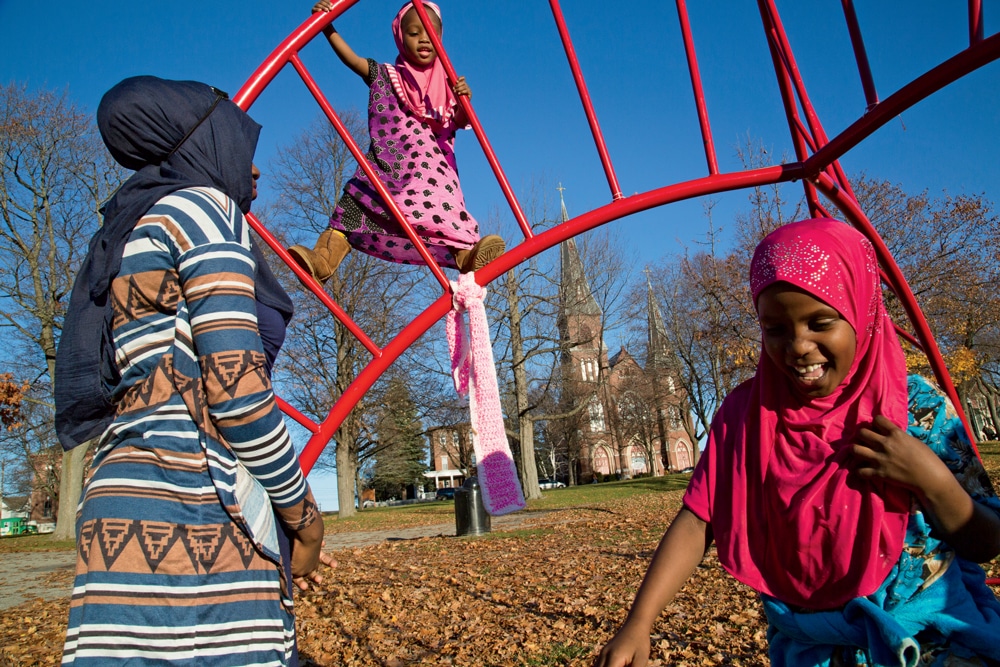
Coffee By Design | Portland, Maine
Photo Credit : Katherine Keenan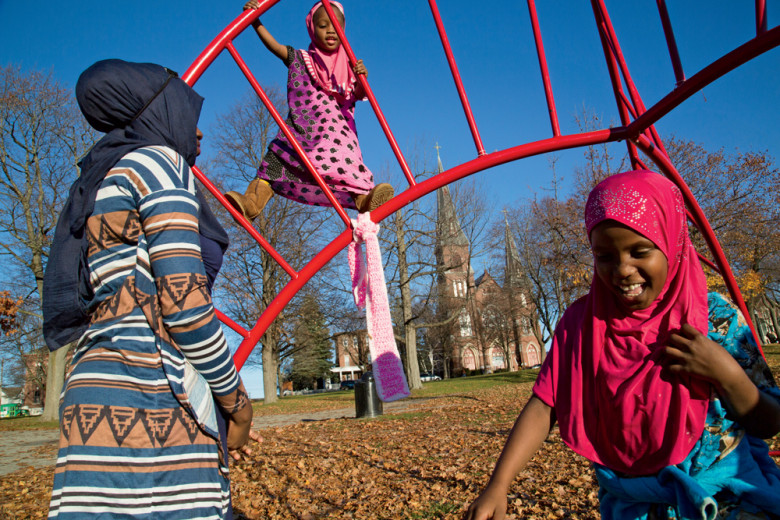
Photo Credit : Amy Toensing
Friday, teachers’ workshop: Kennedy Park in downtown Lewiston, Maine, teems with kids and the energy of a no-school day. Children play tag beneath bare-limbed trees, crisscross the paths on bikes. Flags fly straight in the March wind. A few kids, impervious or optimistic, have shed their jackets, and a couple of boys wear shorts, but mostly hoods are up and coats are zipped. The forecast calls for snow.
Periodically a car pulls up, someone honks, and children come running: a girl in a long skirt and hijab with a ball under her arm, a pair of middle schoolers who were part of tag. Other than women with toddlers at a row of swings, there are few adults. The scene evokes an easier time, when kids ran and played unsupervised and parents let them be.
Before the first refugees arrived here in 2001, before a few dozen Somalis became hundreds and then thousands, before the subsequent waves of asylum seekers from other African nations, Kennedy Park would have been all but empty on a cold spring day. Back then, Lewiston was moribund—a beautiful old ghost of a city whose glory years as a manufacturing hub were long gone. In their wake, a wan service economy had taken hold, but the population drain continued and the core of the city was a shambles. The Lewiston of my ’70s youth—busy sidewalks, women in wool suits and heels, the heady smell in Ward Brothers of everything the cosmetics counter had to offer—was barely recognizable by 2000.
Lewiston needed to stake a claim in the 21st century, and it has—although not one it sought or anticipated. In the past 16 years it’s undergone a transformation as profound as that of any U.S. city, from homogeneous to diverse, underpopulated to revitalized. More than 6,000 of the city’s 36,500 inhabitants are now of African descent. Immigrants work in health care, retail, banking, industry. The downtown is busy once again; classrooms are filled. As Maine’s leaders lament the aging of the state, Lewiston is younger than it’s been in decades.
It’s not utopia. The city still struggles financially, while the needs for social services and education have intensified. Joblessness among the older generation of newcomers remains high, and many speak little English. For some, the effects of a traumatic past hinder acculturation. And while discord has not been pervasive, the racism and Islamophobia that overlay the national social landscape show up here, too.
But there’s a vibrancy in Lewiston that didn’t exist a decade ago. The repopulation has attracted artists and entrepreneurs. A new elementary school is being built. What’s happening is isbedal, the Somali word for transformation.
At Kennedy Park, a van pulls up. A woman gets out and crosses to the basketball court, wind billowing her black abaya. At the fence she waves her arms. A boy in a T-shirt disentangles himself from a group, pulls his coat from a pile. The woman speaks pointedly in Somali, chastisement clear. As the boy thrusts his arms backward into the jacket—“Like this?” he asks, in English—she puts back her head and laughs.
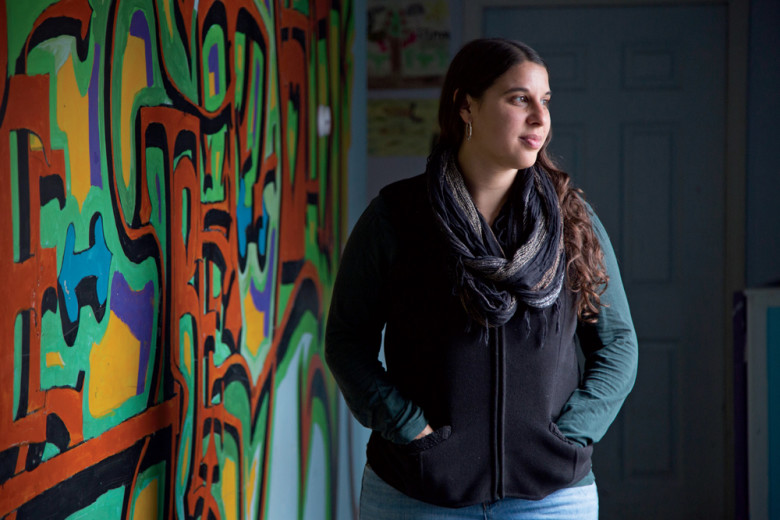
Photo Credit : Amy Toensing

Photo Credit : Amy Toensing
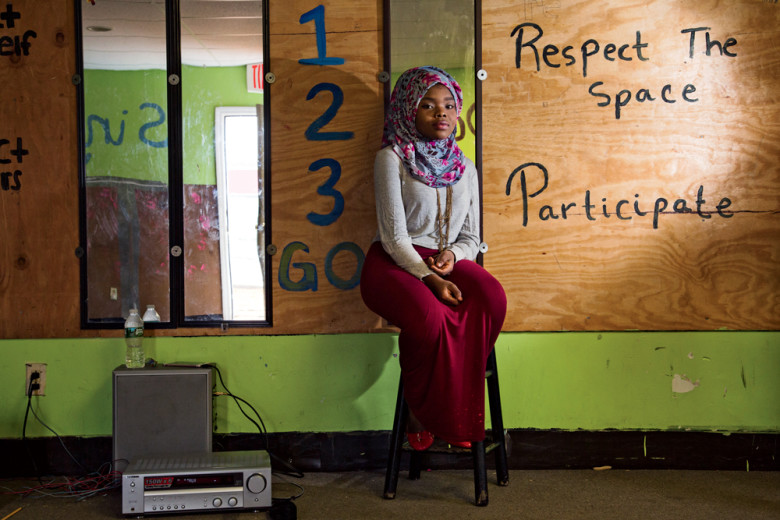
Photo Credit : Amy Toensing
—
In a condo three blocks from the park, 17-year-old Nasafari Nahumure streams The Bold and the Beautiful, fixated on her iPod when she knows she should be studying for the SAT. But these few hours are her haven, a respite from the intensity of school and homework and the youth center where she volunteers. The house is unusually quiet—her younger siblings upstairs in their rooms, her father at work, her mother out. Earlier Nasafari cleaned the house, swept and dusted, wiped down surfaces with Lysol. This bit of time is hers. She sits in her place at the table, close to an outlet and the heater, flicking back a braid or two when they fall forward. On-screen, members of the Forrester family scheme to stay on top of the L.A. fashion world.
The SAT is April 12, and Nasafari needs to do well. She hopes to attend St. John’s University in New York for the paralegal studies that will set her up for law school. But her parents, conservative and watchful, aren’t sure they want Nasafari that far away, given the situation with her two older sisters. One dropped out of high school and lives in a nearby town with her boyfriend; the other moved to Arizona with the family of the church youth pastor. Nasafari’s father keeps a close watch on his third daughter: She has no phone and little in the way of a social life. In navigating the halls of Lewiston High School, where she’s a junior, it helps that she’s outgoing. People know the slim girl in boots and jeans even though they rarely see her at night or on the weekend.
In school, Nasafari’s strengths are history and English—“I like words, adding to my vocabularies,” she told me the first time we met. She’s been learning languages all her life: Kinyamulenge in the refugee camp where her mother, in her third trimester, had fled after rebels pillaged her Congolese village and jailed her husband. Nasafari (whose name means “journey”) was born en route to the camp. While her father remained imprisoned, the rest of the family resettled in Rwanda. Nasafari learned Kinyarwanda there.

Photo Credit : Amy Toensing
After the rebels released her father, he applied for asylum in the U.S. and the family reunited in Maine. Nasafari has lived 11 years in Lewiston, longer than anywhere else. Her English bears traces of Down East: occasional dropped consonants at the ends of words, a two-syllable “there.” She loves Portland (“booming and friendly”) and Freeport for its shopping. Her father’s paychecks from Pioneer Plastics bought this two-story family home.
Five years ago Nasafari walked into the office of Tree Street Youth, the after-school program where she now works, and announced she wanted to be a judge advocate general (JAG) lawyer. Tree Street director Julia Sleeper remembers the moment: “She was 12, a sixth-grader. I didn’t even know what a JAG was.” Nasafari herself can’t recall where she got the idea to join the JAG Corps. “I just knew I wanted to serve my country and also to be a lawyer.”
Sun patterns the room in blocks of light and dark. The Bold and the Beautiful is over. Nasafari switches off her iPod, takes out her homework.
—
Downtown on Lisbon Street, Fatuma Hussein is running late. She is 37, and her days are packed, this one no exception. She needs to get to court in Portland, a 40-minute drive if she pushes the speed limit. The hearing is on behalf of a woman whose husband violated a protective order; Fatuma will be there as an advocate. She has an hour, and she hasn’t eaten lunch—which she must, because earlier this week she learned she’s pregnant with her eighth child. That wasn’t something she was hoping for, exactly, but the weeks of denial ended when the midwife swept a probe across Fatuma’s belly and a baby materialized on-screen.
So there’s lunch to be gotten through and a long drive, and Portland traffic, and Fatuma’s caught in the office doorway while her assistant, Rosaline, issues updates on who’s called and why. Finally Fatuma puts a hand on Rosaline’s arm. “I really have to go.”
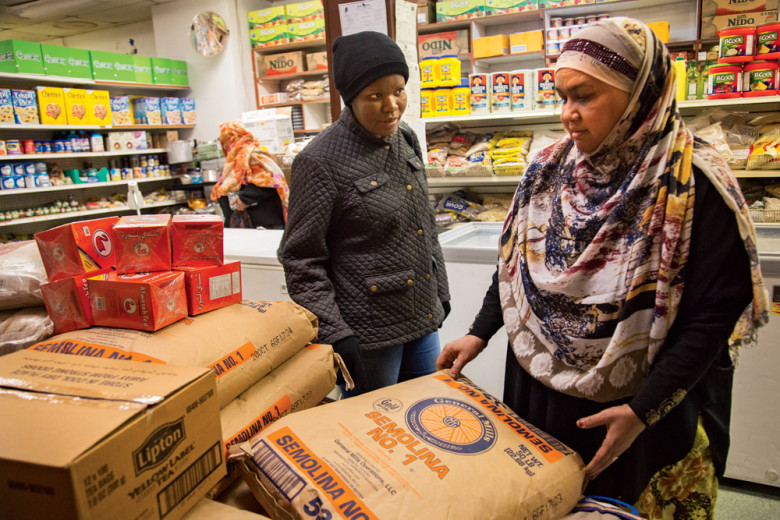
Photo Credit : Amy Toensing
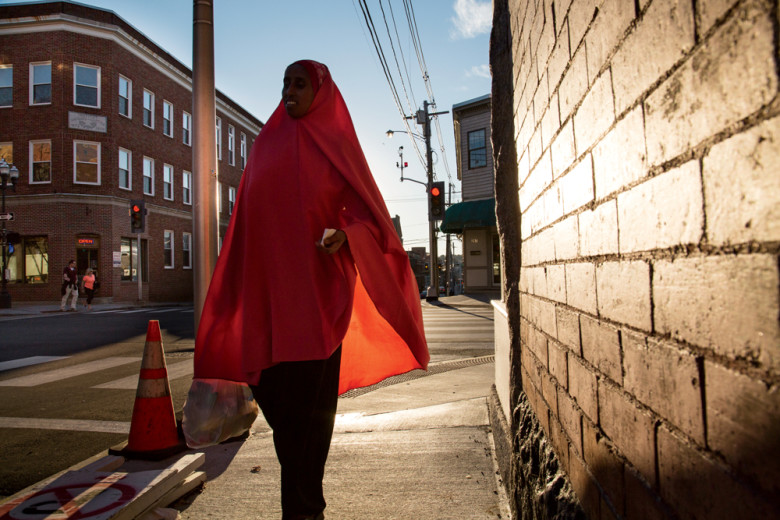
Photo Credit : Amy Toensing
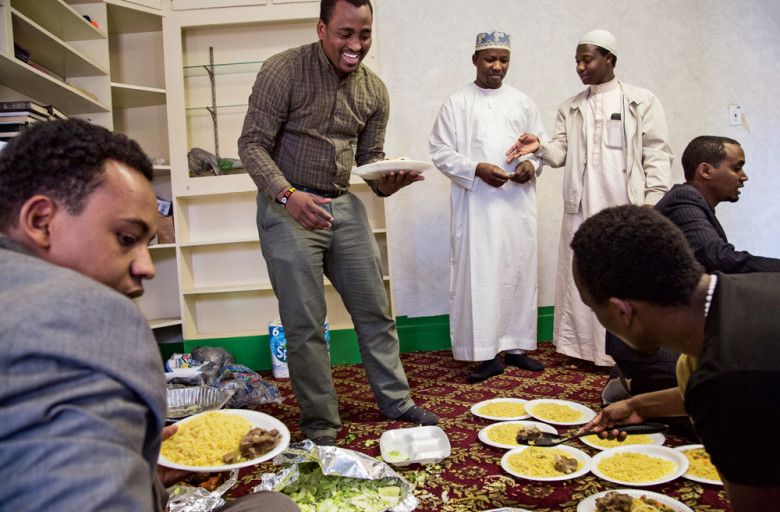
Photo Credit : Amy Toensing
Whenever the topic of Somali leadership comes up, so does Fatuma’s name. The reason for this is partly her charm but also her resolve. She arrived in the U.S. at 12, without her parents, after two years in a Kenyan refugee camp. Within a few years she had married and relocated to Maine, determined to vector loss into forward momentum. The organization she founded in 2001, United Somali Women of Maine, has grown into a successful nonprofit now known as the Immigrant Resource Center (IRC). But there are stresses too: family responsibilities, this pregnancy (which she’s not yet told her children about), and a perpetually jammed schedule. Then there’s the urgency to expand the IRC as other immigrant-headed nonprofits crop up in Lewiston and vie for funding.
The strain of it all sometimes shows in Fatuma’s face. It’s showing now. Even so, at the restaurant across the street she and the proprietor greet each other warmly. As-salaam alaikum. Wa-alaikum as-salaam. Within minutes, a steaming platter of chicken and rice appears at her table, where Fatuma perches watching the clock. Save for the table, the TV, and a plush prayer rug, the persimmon-hued room is empty. It typifies the Somali aesthetic for indoor spaces: bright and uncluttered, pared of material possessions.
Dutifully Fatuma finishes her chicken and some salad, takes a long swallow of orange Fanta. Her phone rings: Rosaline. The client is en route to court. Fatuma asks Rosaline to call the interpreter, to confirm her arrival time. And then she’s off, headed south on the highway. She gets there just in time to take the hand of the woman and listen to the long proceedings. Then she’s back in her SUV, driving north and west into a reddening sky, arriving home to cook dinner and tuck her younger kids into bed before checking the older ones’ homework. It’s easier when her husband is home, but he’s a trucker and often out of state.
The next morning she’s on the road again, to and from Augusta and then south to Portland for an observance of International Women’s Day. In Portland, she takes the microphone, talks about the need for women’s-rights advocacy and, more generally, about the state’s immigrant presence. “We are not a burden. We come, and we succeed,” she tells the crowd to echoes of “That’s right.” Applause grows as she continues, “The state of Maine is lucky to have us.”
Back in his office in Lewiston, deputy city administrator Phil Nadeau agrees. “Things are good and have been for a while,” he says.
The early years were rocky. The first to arrive were Somalis who came north from Portland, where housing was scarce, in February 2001. Maine was cold, and homogeneous (it was then the second-whitest state in the nation), but it offered safety and access to services, and a lower cost of living than places like Atlanta, where the federal government had first resettled the refugees. Moving to the extreme Northeast was their choice—a gutsy one, considering that photos shared through social media showed snow banked four feet high.
In Lewiston, a handful of families turned into a few dozen, and then several hundred. For a while, as many as 50 Somalis were showing up by Greyhound bus each week. Most settled into the vacant triple-deckers that fanned out from downtown Kennedy Park. By the end of the summer, almost 1,000 newcomers had moved in. The city scrambled to provide language and social services. There was pushback about who would pay for what, and how. The situation was complicated by the fact that federal money set aside for refugees doesn’t follow them if they move from original resettlement locations—and is short-term, in any case.
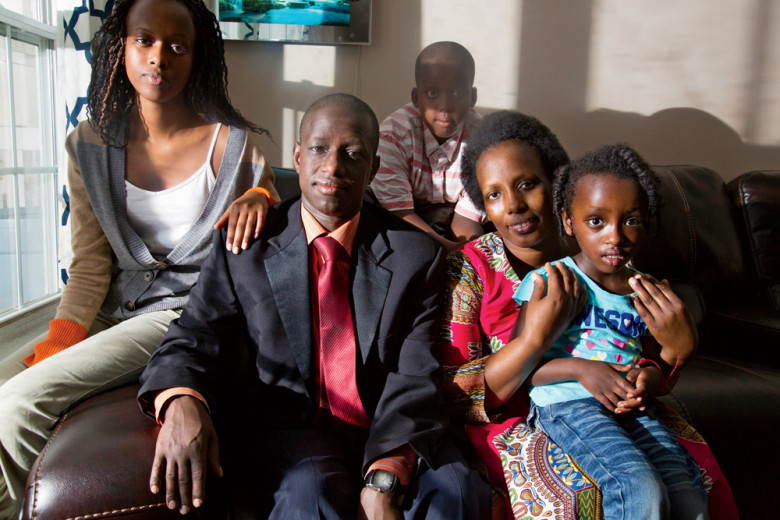
Photo Credit : Amy Toensing
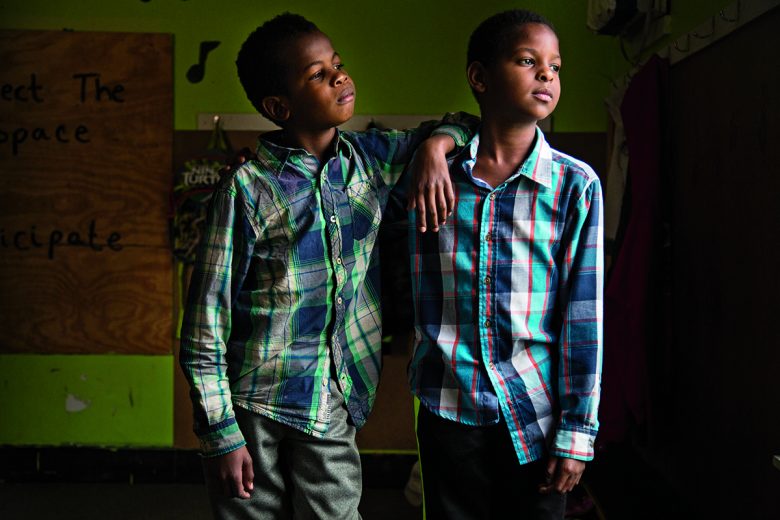
Photo Credit : Amy Toensing
It seemed to me then that longtime Lewiston residents were responding to the changes in accordance with their natures: curious, or suspicious, or holding off on judgment. But tensions were rising. In October 2002, then-mayor Laurier Raymond wrote an open letter urging Somalis to stop inviting friends and family members to join them. “This large number of new arrivals cannot continue without negative results for all….[W]e need breathing room.” The now-infamous letter triggered a chain of reactions, including a poorly attended white supremacist rally and a sizable counter–demonstration at nearby Bates College.
The refugees kept coming. The New Yorker called what was happening in Lewiston a “large-scale social experiment”—a blunt but not wholly inaccurate assessment. There were, after all, now several thousand African Muslim immigrants in a city not known as a liberal outpost. Pickups with Confederate decals regularly parked downtown, and stories about the newcomers in the local Sun Journal triggered xenophobic online rants. Fatuma recalls verbal abuse and taxi drivers who refused to pick up Somalis, and white men exposing themselves to immigrant women.
But if there was an ugly undercurrent, increasingly the tone was one of accommodation and accord. In 2006, when a man threw a pig’s head through the doorway of a Lewiston mosque while people inside were praying, the reaction—at least publicly—was unanimous. The deed was denounced, the offender criminally charged. The imam urged mosque members not to retaliate, and the broader community drew close around the Somalis.
Jamilo Maalim, who arrived in the city in 2003 as a 9-year-old, remembers a more welcoming reception overall than the one in Dallas, where she’d first been resettled with extended family. “People were just friendlier in Lewiston,” she says.
Now 22, Jamilo lives in a downtown apartment—a Somali-spare yet cozy place decorated with garlands of plastic flowers and framed photos of her son and daughter. The living room holds a leatherette sofa, a TV, and a big soft rug where the family sits to eat their meals. Jamilo’s physical traits—the slight set to her chin, the upright posture, the open but searching gaze—suggest both sensitivity and resilience. As an infant she was separated from her parents after the Somali civil war intensified; an aunt escaped with her to Kenya. Three years ago she learned her parents were alive and living in the same refugee camp where she had been. Right away she began to save money for a trip. Last spring she flew to see them. “When I got there, I was in such a rush. It was like, There’s this lady. I’m told she’s my mother.” She pauses, blinks back tears. “When I hugged her, I felt like I knew her.”
Jamilo stayed in Kenya six weeks, and now keeps in regular contact with her mom and other family members there via phone and social media. But she doesn’t think about leaving Lewiston permanently. She’s a working single mom who values health care, education, community. In many ways the city has formed her.
While Jamilo was growing up—entering third grade in a new place, finding friends, figuring out how to be both American and Somali—TV and newspaper accounts of what was happening in Lewiston focused on isolated, dramatic incidents. The mayor’s letter, the rally, the pig’s head. What’s really transpired in Lewiston is quiet forward motion, a lot of hard work by longtime residents and newcomers alike. The city’s initial unpreparedness may have worked to its advantage: As officials scrambled to build programs, they had to partner with churches, hospitals, schools, and the refugees themselves in ways that established broad, inclusive bases.
But mutuality and steady, imperfect progress are not the stuff of headlines. Every time Muslims or refugees are in the news, reporters still call Phil Nadeau looking for edgy follow-up.
What’s happening in Lewiston? they ask.
Nothing’s happening in Lewiston, Phil tells them.
In his city hall office, surrounded by photos of Lewistonians and a street map that stretches overhead, Phil smiles and settles back in his chair. “I love saying that.”
And yet—much remains at stake. Kids who arrived as refugees or asylum seekers are heading off to college in rising numbers, but will they return to Lewiston? Will there be jobs if they do? And the climate, not the cold and the long wait for spring, but the social climate: What will happen in the wake of the presidential election and during the next four years? The newcomers need opportunity and a sustained sense of welcome. Lewiston needs its new residents to settle in and continue to build lives. To stay.
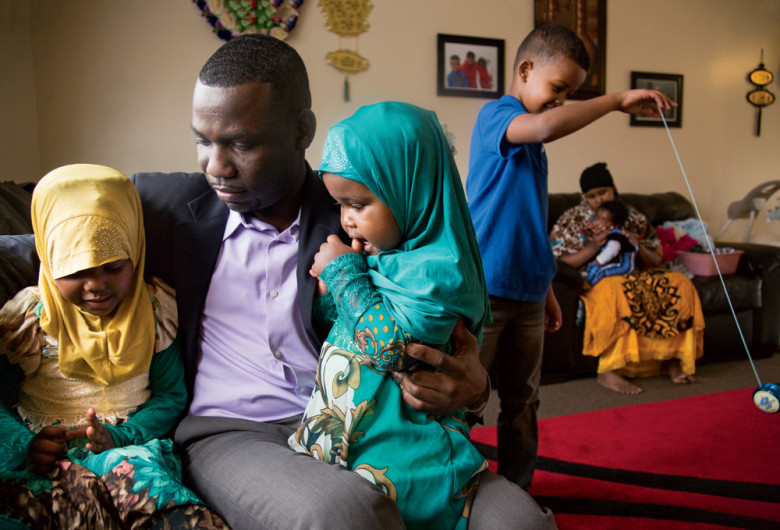
Photo Credit : Amy Toensing
—
In mid-April at Tree Street Youth, Carrys Ngoy practices keyboard for an upcoming performance, though not wholeheartedly. Whenever he stops, hip-hop filters in from down the hall where kids work on a dance routine. The floor reverberates with bass and pounding feet. In two weeks Carrys will perform his piece with his best friend and housemate, Isaac Kabuika, who right now is at Bowdoin on a three-day visit for accepted students. It’s hard to play without him.
Carrys and Isaac have much in common: both high school seniors, Congolese, both in the U.S. without parents. Both seeking asylum because of peril in their country. Their friendship was cemented in AP Calculus II, where they’re two of only three students in the class.
At home in their shotgun-style apartment, Carrys and Isaac share chores and hang out when they’re not at their desks. They talk religion and philosophy, wash down any disagreements with Welch’s sparkling grape juice. For all they have in common, the two have different styles: Isaac, forthright; Carrys, deliberative and wry. Recently Isaac announced that he didn’t like to cook and hoped to marry a woman who does. Carrys eyed him sidelong. “She might not like to cook either,” he said. Isaac nodded, smiled. “We’ll take turns and eat out on my nights.” In the meantime, Isaac buys stuff to microwave while Carrys experiments with cooking from scratch.
With Isaac away, Carrys is spending much of his time at Tree Street. “Actually, it’s lonely at home,” he says in French-inflected English. He’s been in the U.S. 15 months to Isaac’s two years and is unsure where he’ll wind up in the fall. The University of Maine at Orono accepted him into its engineering program, but, unlike Isaac, who got a scholarship, Carrys doesn’t know how he’ll come up with the tuition. As an asylum seeker he can’t apply for federal loans, and although he’s filed for an asylum hearing, the backlog of cases means it could be years before he learns whether he can remain in the country.
So Carrys waits: for news about private scholarships, for his hearing, for alternatives for September. Maybe he’ll take classes at the community college. Maybe he’ll stay on at Tree Street as staff. He does love Lewiston, he says. For tonight, he’ll eat some leftover pork and beans he made. Isaac will be home on Sunday.
At a table in the room next to where Carrys is practicing keyboard, Nasafari is in her own state of uncertainty. The SAT was Tuesday, and she’s not sure how it went. The verbal portion seemed OK, but the math was challenging. Plus, she felt off that morning: It was raining, she got to school late, ate little breakfast. She sighs, flicks a braid. “Maybe I did fine.”
A boy appears in the doorway. He smiles at Nasafari, leans there for a while, waiting. Eventually she smiles back. After he leaves, Nasafari is quiet. They are not dating, she says finally. “I mean, I don’t do relationships. School and my family come first.” As she speaks, she looks older than 17 and also very young.
Last week a woman came to Tree Street to talk about her path to a career as an attorney. Nasafari’s face gains composure as she describes how the woman raised her siblings and married young before attending law school. “It was really inspiring. I’d love to job-shadow her,” she says.
For a majority of the kids at Tree Street, their experience at the center culminates in the college prep program. Application essays paper one wall, and acceptance letters another. They’re there, Julia Sleeper says, partly for celebration but also, and more importantly, so that the younger children will be inspired.
About 130 kids come through the doors every day. Most are African immigrants, a few are native Mainers. Hand-painted lettering on the dance room wall sums up the center’s approach: Respect yourself. Respect others. Respect the space. Participate. The place is not always a haven of good behavior—there are back-talking kids and misbehaving ones, children in whom the effects of trauma are clearly evident—but it emanates a steady warmth.
At 30, Julia has worked in Lewiston’s immigrant community for more than a decade, since she was a student at Bates. She founded Tree Street in 2011 and recently raised more than $1 million to renovate its quarters in a former paint shop. “It’s very exciting,” she says of what’s happening at Tree Street and, more generally, in Lewiston. “Things have evolved so much over the last decade. There’s been tremendous growth, collectively and individually. Of course there are difficulties—the issues are complex and thousands of lives are involved—but when you see people overcoming, when you see success, it’s very motivating.”
Her investment in the kids is obvious two weeks later at the performance in the atrium of the refurbished Bates Mill. From the front row, she mouths the words to all the songs and spoken pieces. The kids dance “Powerful” and “Cultural Mash-up,” and Julia sways and bounces in her seat, anticipating every move.
—
In May, Carrys learns the University of Southern Maine has accepted him—he applied at the last minute, when other prospects weren’t looking good—and awarded him a $2,500 scholarship. For days he goes around smiling. During the school year he’ll live in Portland, off-campus to save money, and he’ll start out studying math and science, since USM doesn’t offer engineering.
Nasafari’s news is not as good. She didn’t do well on the SAT—poorly enough that she won’t reveal her scores. She points out, though, that her last name, Nahumure, means “patient.” In the coming months she’ll redouble her prep for a fall retest.
At the IRC, Fatuma learns that Rosaline is moving to Dallas. While Fatuma is happy for Rosaline and her family, the timing isn’t great: Fatuma’s five months pregnant now, fatigued and a little overwhelmed, realizing how much she has to do to prepare for several upcoming conferences.
But a few weeks later, at a celebration of World Refugee Day at Simard-Payne Park, she’s her usual self—greeting people, accepting an award, dancing to Somali music with her husband and others on the outdoor stage. People clap, cheer. Steam rises from tables of African food: fish stew and muamba, cassava and sambusas—free, and popular. Women refill serving dishes. The site, fittingly, is a former rail yard for trains that carried 19th-century immigrants from Canada to work in the Lewiston mills. Now it’s part of the Androscoggin River Walk, and a public recreation space.
Fatuma had worried that the leaden sky would keep people away. But a crowd that’s half black, half white mills around, kids darting among adults, who step aside as they balance plates. Teens jockey for position around Mike McGraw, who coached the Lewiston High soccer team to its first-ever state championship in 2015.
On nearby Oxford Street a truck slows, honks, then revs its engine and speeds by. Two food servers glance up apprehensively; the national rise in anti-immigrant sentiment has people on alert. Although overt hostility is not common—crime has dropped during the past decade and continues to decline—racial and anti-Muslim bias lingers among some in Lewiston. So does a conviction that the newcomers consume a disproportionate share of welfare dollars, although that view is not borne out by the numbers. Somalis, who make up about three-fourths of the city’s new residents, received general assistance at a lower rate than the nonimmigrant community in 2015, for instance, and housing vouchers commensurate with their population.
One challenge to community cohesion is that, other than schools and commerce, the orbits of longtime residents and newcomers often barely overlap. “We need to integrate more,” says Abdikadir Negeye, the 31-year-old human resources director of Maine Immigrant and Refugee Services (MIRS). “We should know each other better and share in each other’s cultures.”
The closeness of the immigrant community itself is a source of resentment for some in Lewiston. A store owner complains mildly about business loans available to newcomers, then, more heatedly, he says, “They don’t do things like the Dempsey Challenge [cancer fund-raiser] or the balloon festival. They keep to themselves…. You can see it as exclusive.” Robust support structures among Somalis, in particular, may foster this perception. Outreach is immediate when new people arrive—they’re taken in, fed, shown around. Women collectively shop in bulk and watch each other’s children; inside the mosque on Lisbon Street, preschoolers flow as a single unit before Friday prayers. Rotating credit and co-ownership of possessions facilitate the purchase of cars and other items.
After arriving from Kenya in 2005, Abdikadir spent months hosted by one family after another. “Everyone tries to make sure you’re happy and safe,” he says. Somali emphasis on communality is so fundamental that it has subsumed significant differences between immigrant groups. Abdikadir is Bantu, a marginalized Somali minority that began resettling in Lewiston in 2005 alongside ethnic Somalis. In their home country, the divide between the two groups is vast. In Lewiston an affinity has emerged, born of dislocation and reflexive hospitality. “Here, relations are better,” Abdikadir says. “We talk about our similarities and work on our differences.”
Some believe the African emphasis on mutuality and community will translate well in Lewiston. At Refugee Day, a woman who came with her daughter put it like this: “Mainers are warm and so are the Somalis. We have our children and our city in common, and this beautiful state. There’s a lot to care about.”
In a city that loves its sports, soccer is another unifier. The 2015 championship team included players from Somalia, Congo, Turkey, and Germany. From the start, Coach McGraw insisted they were “one team, together on and off the field.” As the season went on and LHS kept winning, their fan base grew to several thousand, many of whom traveled to Portland for the final game against Scarborough.
Abdikadir coached many of the players when they were children. “To see that team win, what it meant to our city, it still makes me emotional,” he says.
Fatuma attended the party held two weeks later at the Ramada Inn. “It was so diverse,” she says. “I looked at the crowd and I thought, This is who we are. The whites and the blacks, the young, old, women, children, men—all of us were there to celebrate our boys.”
—
On the morning of Eid al-Fitr, the celebration at the end of Ramadan, shoes are piled everywhere at the entrance to the Lewiston Armory. Inside, hundreds of people sit on prayer rugs or on the floor of the huge space, men on one side, women on the other. People murmur greetings, embrace; girls take each other’s hands and admire henna tattoos applied for the occasion.
The service begins with the Muslim call to prayer: Allahu Akbar, Allahu Akbar. As everyone kneels in unison and touches forehead to floor, fabric shushes like wind. The armory is used for this holiday and two months from now for Eid al-Adha because the city’s two small mosques don’t have enough capacity.
After the service, people stream into the warm July day. Kids shout and run beneath the trees. The month of daily fasting and self-reflection is over. Eid Mubarak! everyone calls. Happy Eid! From here, family groups and friends spread out in different directions, for elaborate meals that have been days in preparation, for trips to parks and lakes and relatives in other cities. Abdikadir goes with his wife and kids to his mother’s house. Fatuma and her family head for Six Flags so the kids can ride the Buzzsaw and the Wicked Cyclone. Other families drive to Boston, Old Orchard, Rhode Island, upstate New York, toddlers buckled into their boosters and, later, parents drinking tea to stay awake on the long trip back to Lewiston. Many Somalis love to travel—some attribute it to their nomadic roots—and there’s no better excuse for a road trip than Eid.
That evening in Kennedy Park, the benches are still occupied as dusk gives way to dark. People wind up picnics of goat or beef, rice, and salad—and the ubiquitous bananas that accompany every meal, to be sliced into the rice. Younger kids who earlier kicked around a soccer ball and somersaulted in the grass now snuggle in their parents’ laps. By the basketball courts, two women watch a man and a girl trace figure eights with sparklers left over from the Fourth.
Inside Speaker’s Variety, the cashier is a little testy. “No more dollar bills!” she tells the kids gathered on the other side of the counter. “I’ve gotten 300 of them today and I’m out of change.” But she’s not stern as she says it, and the kids crack up. It’s true they’ve brought in a lot of singles: Say Eid Mubarak to an adult, and it might elicit a dollar—a transaction that’s occurred countless times today.
On the sidewalk a group of kids peel wrappers from candy and open chips they bought after coaxing the cashier to take their singles. When I ask what Islam means to him, a boy recounts its pillars: care for the poor, the Hajj (pilgrimage to Mecca), pray five times a day, fast during Ramadan. He pauses. The Quran, another boy says. Right, says the first. Say you believe in Allah, and that Muhammad is his messenger. The other kids nod; he’s got it.
—
In Jamilo’s apartment, the curtains are drawn against the sun. Outside, the late-summer heat is a wall. Residents of the four-story complex fan themselves on stair decks that double as porches. The doors to units with AC are closed, the ones without it open in hopes the air might stir.
Here it’s cool, or cooler, and quiet. On the sofa, Jamilo’s 3-year-old daughter leans against her, licking a popsicle. Fifteen-month-old Hamzah is upstairs asleep. “Careful you don’t drip, Aaliyah,” Jamilo says. The child nods, cranes her neck to look at photos her mother scrolls through on her phone in reverse chronology: pictures of the kids dressed up for Eid, some shots from May, then back to March, when Jamilo visited Dagahaley, the refugee camp where she had lived. She stops at a photo of herself with others in a dusty courtyard. “There they are,” she says—her extended family. She still can’t quite believe she was back there, in Dagahaley, for six weeks, can’t believe she got to be with her mother and meet her younger siblings. There’s wistfulness as she says, “So many people remembered me.”
Jamilo likes to cook—Somali dishes, pasta with homemade marinara, fried chicken with corn—and many of her anecdotes about her trip revolve around food. The anjera, perfect, not too tart, with bits of vegetables mixed in; the carefully spiced chai with goat’s milk. “They have so little but they cook so well,” she says.
Aaliyah sits on the floor now, playing with an iPad. Then she’s up, climbing the carpeted stairs and riding down on her bottom. “Look!”
“Try to be quiet,” Jamilo says, but it’s too late—Hamzah appears. Aaliyah helps him down the steps. Jamilo hands him a popsicle. He takes a few licks, widens his eyes. “No,” he says, his current pronouncement on almost everything. Aaliyah tickles his belly. He giggles, keeps licking. “No.”
As the kids play, Jamilo talks about nighttime in Dagahaley. Her animated face stills. It was frightening. There were thieves, and men trying to get into the compound to assault women. “They grease themselves so they can get away.” She takes a deep breath. “Not while I was with my family, but it happens a lot.”
In Lewiston Jamilo has worked for Xerox in customer service and at MIRS. Soon she’ll start full-time as a fuel assistance certifier. Her paycheck is spread among babysitters, rent, utilities, groceries. She’s also started sending money to her family in Kenya, a widely practiced custom called biil. “Food is very, very expensive there. I feel I should do what I can to help.”
Like many young immigrants in Lewiston, Jamilo seems less interested in assimilation than additive acculturation, one in which her American identity exists alongside her Somali one. Her computer fluency, close ties to Kenya, love of hip-hop, her hijab, trilingualism, abstinence from alcohol—all of it is who she is.
For Abdikadir, too, becoming a Mainer has been a cumulative process rather than one of substitution. He holds tight to Somali values around the centrality of community and de-emphasis on individualism and material possessions. Like Jamilo, he remains close through social media with friends and family in Africa. Yet it’s hard to imagine someone deeper into a new life. Since arriving in Lewiston he’s graduated from high school and college, become a citizen, married, and fathered four children. He cofounded the association that evolved into MIRS. In May, the Lewiston-Auburn Chamber of Commerce named him to its “40 Under 40” list. “I am so grateful,” Abdikadir says of the access to opportunity he’s had in the United States. As a Mainer, Somali-Bantu Muslim, and trans-national citizen, he is quietly expanding what it means to be American.
—
Carrys begins classes at USM at the end of August. Two days later Isaac starts at Bowdoin. “All is well,” Carrys says in one of his messages from Portland, where he’s living in an apartment with other students. In Lewiston, Nasafari launches into her senior year at LHS. After school she works in a day care to save money for college; her plan is to apply early-decision to St. John’s. The SAT is scheduled for October 1. This time, she says, she is ready.
On a sunny September afternoon, Fatuma makes her way up Lisbon Street, store by store, with U.S. congressional candidate Emily Cain. Fatuma’s baby—a boy, she now knows—is due any day; until then her schedule will remain packed. Inside the Mogadishu Store, she introduces owner Shukri Abasheikh as “Mama Shukri,” a Somali honorific. Emily Cain tells Shukri she’s an advocate for jobs and education. In turn, Shukri affixes the candidate’s placard to her register, says there are five voters in her family.
Shukri has owned Mogadishu for 10 years. Like many shops on Lisbon it has several branches: a full line of groceries; translation, tax, and money-wiring services; and, in the back, a two-table restaurant. Mogadishu’s sambusas are known all over town. Shukri also runs a clothing business. On weekends a woman she met when their children were in kindergarten stitches wedding outfits in pink and peacock blue and purple while shoppers step around her.
Just before leaving the store, Fatuma turns to Shukri’s daughter, Farhiya, who’s restocking bottles of mango juice. “Young people like you need to come out and vote,” she tells her. “We all need to exercise our rights.” Farhiya nods, locks eyes with Fatuma. In November, she will vote.
The next afternoon, Jamilo and other moms relax on the grass in Kennedy Park. Babies crawl from lap to lap, and everyone shares a bag of ginger chews. Aaliyah wants the password to someone’s—anyone’s—phone. The moms talk about inexpensive places to shop for groceries, then the topic shifts to the upcoming holiday, Eid al-Adha. The date had been uncertain because Muslim holy days are determined in real time, based on the lunar calendar and new-moon sightings.
“I’m so glad it won’t be September 11,” Jamilo says. “People might misunderstand when they see us hugging and, you know, happy.” The other moms nod. “I mean, I feel terrible about that day,” Jamilo says, her face grave. I think of reminding her that she was 7 years old on 9/11, still living in Kenya, but of course she knows that.
The moment passes. Aaliyah goes over to the swings. Then a man with tattoos passes by, a live snake wrapped around his torso. Aaliyah rushes back, eyes wide.
Jamilo reaches for her. “You’re safe here,” she says.
Postscript
On November 9, the day after the election, Jamilo texted me. She’d voted for the first time—for Hillary. She was shocked at the outcome, she said, and worried for herself and other Muslims. Then she added: God Bless America! I still love this country!
That was Wednesday. On Thursday she was walking home from work at lunchtime to cook chicken. As she stepped into a crosswalk, a motorist sped past, shouting for her to remove her hijab. After running into a nearby health center for safety, she sent another text: I’m terrified. She began keeping her phone in hand and on camera whenever she left the apartment.
A few days after the crosswalk incident, although she was still feeling shaky, Jamilo reiterated her love for the U.S. “Lewiston is my home,” she told me.
I’m worried, of course, for Jamilo and for all of the city’s new immigrants in the current climate. But I’m also hopeful. Despite fickle federal and state support over the past 16 years, Lewiston rose to the occasion. So did the newcomers. The divides of religion and race are far from healed. Other challenges remain. But quietly, intentionally, the city and its people have moved forward. I hope America is watching.








This is so beautiful and true.
Why does it have to be instead of your t-shirts, etc. I’m betting Bates Graduates can afford a t-shirt and a charitable element.
In June of 2016, the Bates College Class of 1976 celebrated its reunion by raising money for Tree Street Youth rather than spending money on reunion t-shirts and other non-essentials. I am proud to be a member of a class that cares about and gives back to the city of Lewiston. This article is both inspirational and motivational and was circulated among members of my class. The Class of’76 is planning to return to Lewiston this spring for a workday at Tree Street Youth.
Kudos to Lewiston and kudos to the African immigrants who have become an integral part of this successful and vibrant community. Thanks to Yankee and Ms. Anderson for this beautiful story.
Thank you for this story, which in addition to being about an important subject is very well written with great photographs. Enjoyed it a lot!
Thank you for this moving story. It brings to life people ane a place that I would not have gotten to know otherwise.
Nicely written. I do not live in Lewiston, I left many years ago. I do go back to ME because I have cousins. I live in a rainbow neighborhood and I can tell from personnel experience that I have a much better life embracing people who talk a little different and worship in different churches (Temples or Mosques).